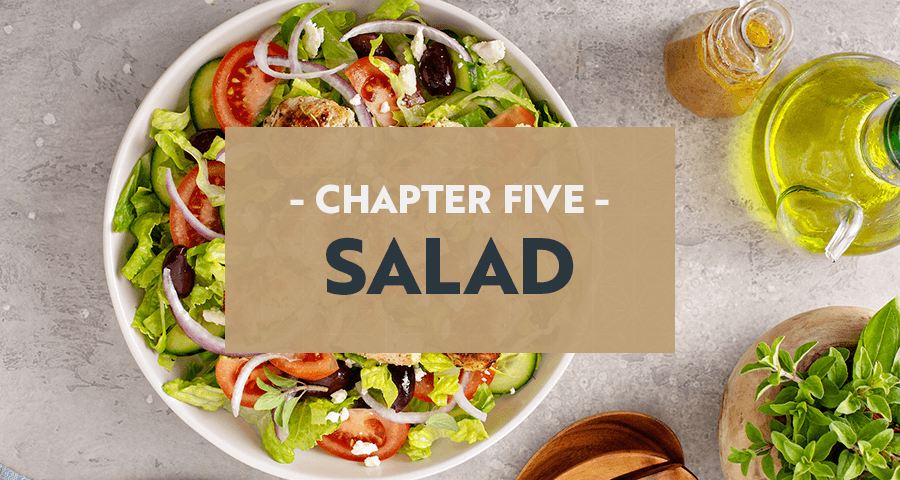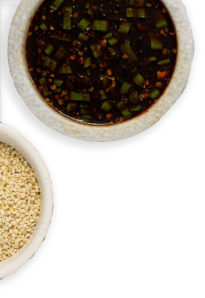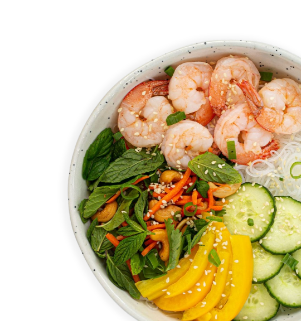
Chapter 5: Salad
Building a salad can be simple. Tossing together ingredients and dressings can make a filling bowl, but many make the mistake of using extra ingredients they don’t need or pilling cheeses and fried foods until the dish becomes unhealthy. Crafting a great salad with nutritious ingredients can be fun, and you can create many exciting combinations.
How to Make the Perfect Salad
Salads can be an excellent way to serve a refreshing and healthy dish with vitamins, minerals and vegetables or fruit. However, many people make these common mistakes that diminish their salad’s nutritional value:
- Overload on toppings: Croutons, cheese, bacon bits, crispy noodles and fries have appeared on many salads, adding extra sodium, calories and fat.
- Deep fry the protein: While grilled chicken and other meats have nutritional value, deep frying the protein source involves adding oil and breading that loads the dish with fat and unnecessary calories.
- Serve large portions: Too much of anything can be bad, even salads. Serving large bowls of salad can add additional calories your customers don’t need, especially if you’re choosing to add more meat, cheese and toppings rather than leafy greens.
- Drown it in dressing: A well-proportioned salad only needs a little dressing, but many restaurants overload their salads with dressing or pour too much into side containers, adding additional salt, sugar and high amounts of saturated fats.
Don’t make the mistake of decreasing your salad’s nutritional value. Learn how to make a good salad by following these tips:
Start With the Base
Prepare your salad by laying a leafy bed of greens. Skip the iceberg lettuce and opt for flavorful kale, cabbage and rich-colored greens instead. Don’t be afraid to use more than one type to keep it interesting and colorful.
Add Some Additional Produce
Brighten your salad with fresh ingredients. You can choose dried, raw or roasted veggies and fruits to top your dish. Stick with non-starchy vegetables, like cucumbers, tomatoes, bell peppers and broccoli. Then, add flavorful produce like onions, pickled vegetables and olives.
Choose a Protein
Protein can give your salad the nutritional boost it needs. Adding a protein source can make your guests feel satiated and bring more flavor to the dish. Avoid deep-fried options and those with high amounts of saturated fat. Ensure you offer various protein sources to accommodate customers who don’t eat certain meats or animal products.
Include Some Healthy Whole Grains
Quinoa, brown rice and whole-grain pita are excellent ways to incorporate this food group into your dish. Refrain from the traditional fried croutons and opt for foods that can provide energy. Be sure to offer gluten-free alternatives to satisfy all your guests.
Add a Crunch
You can add a delicious crunch to complete this soft meal without opting for fried options. Seeds, baked legumes and nuts can give that extra flavor and pack a nutritional punch. You can also add spices and herbs to create flavorful combinations for every salad.
Drizzle Your Dressing
Dressings can pull your dish together, but adding too much can diminish the other flavors and nutritional value. You don’t have to serve splashes of vinegar to keep salads healthy, either. Create special house dressings using ingredients like apple cider vinegar, honey mustard, lemon juice and olive oil that impress your guests and enhance their meals. Contact us to learn more about how our delicious ingredients can complete your salads.
Learn How to Make a Great Salad From San-J
Complete your salads with delicious ingredients that pack a punch. You don’t have to stick with the typical recipes for your menu. You can check out San-J’s recipes for salad and meal inspiration to add to your menu. Find nutritional and delicious ingredients that keep your guests coming back for more.



